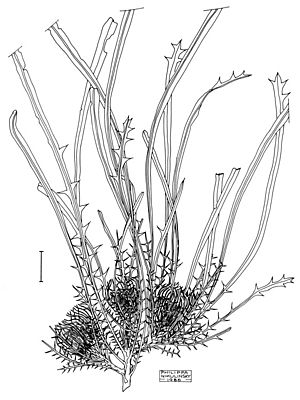Banksia subpinnatifida facts for kids
Quick facts for kids Banksia subpinnatifida |
|
|---|---|
 |
|
| Illustration by Philippa Nikulinsky | |
| Scientific classification | |
| Genus: |
Banksia
|
| Species: |
subpinnatifida
|
| Synonyms | |
|
Dryandra subpinnatifida C.A.Gardner |
|
Banksia subpinnatifida is a special kind of bushy shrub. It grows only in the southwest part of Western Australia. This plant has unique leaves with sharp teeth. It also has pretty golden yellow flowers that grow in groups. After flowering, it produces smooth, oval-shaped fruits called follicles.
What it Looks Like
Banksia subpinnatifida is a bushy shrub. It usually grows up to 1.6 meters (about 5 feet) tall. This plant does not have a special woody base called a lignotuber.
Its leaves are long and narrow. They can be from 50 to 350 millimeters (2 to 14 inches) long. The leaves are also 2 to 16 millimeters (0.08 to 0.6 inches) wide. Each leaf has a stalk up to 20 millimeters long. There are up to fifteen widely spaced teeth on the lower half of the leaf.
The flowers are a bright golden yellow color. They grow in groups of about sixty to seventy flowers. These flower heads often appear close together on short side branches. At the base of each flower head are small, leaf-like parts called bracts. These bracts are 11 to 20 millimeters long.
The flower parts are covered in soft, woolly hairs. The main part of the flower is 26 to 28 millimeters long. The female part of the flower, called the pistil, is 34 to 41 millimeters long. It is gently curved and smooth.
Banksia subpinnatifida flowers from September to October. After the flowers, it produces smooth, oval-shaped fruits. These fruits are called follicles and are 9 to 13 millimeters long.
How it Got its Name
This plant was first officially described in 1964. A botanist named Charles Austin Gardner gave it the name Dryandra subpinnatifida. He published his description in a science journal. The plant samples he studied were collected by Fred Lullfitz.
Later, in 1996, another botanist named Alex George described two types of Dryandra subpinnatifida. These were called varieties:
- Dryandra subpinnatifida subsp. inerbis: This variety has about sixty flowers in each head. Its bracts are up to 20 millimeters long.
- Dryandra subpinnatifida subsp. subpinnatifida: This variety has forty to fifty flowers in each head. Its bracts are up to 12 millimeters long.
In 2007, two scientists, Austin Mast and Kevin Thiele, moved all Dryandra plants into the Banksia group. So, this plant became Banksia subpinnatifida. Its varieties also changed names to Banksia subpinnatifida var. inerbis and Banksia subpinnatifida var. subpinnatifida.
Where it Lives
Banksia subpinnatifida is found in Western Australia. It grows in the area between Pingelly and Tambellup.
The inerbis variety grows between Boddington and Broomehill. The subpinnatifida variety grows in thick scrub between Pingelly and Narrogin.
How it's Protected
The Western Australian Government Department of Parks and Wildlife says that Banksia subpinnatifida as a whole is "not threatened." This means it is not in danger of disappearing.
However, its varieties have different protection levels:
- The inerbis variety is listed as "Priority Three." This means we don't know much about it, and it's found in only a few places. But it's not in immediate danger.
- The subpinnatifida variety is listed as "Priority Two." This means it's also not well-known and found in only one or a few locations.

